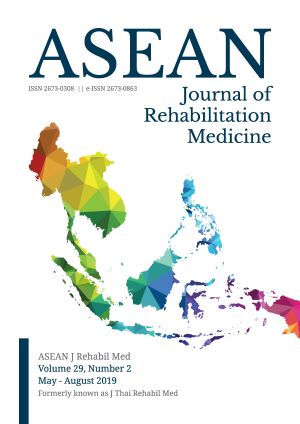the Effects of Inspiratory Muscle Training on Hand and Mobility Functions in Subacute Stroke
Effects of Inspiratory Muscle Training on Hand and Mobility Functions in Subacute Stroke
Keywords:
hand grip strength, inspiratory muscle training, sit-to-stand, subacute stroke, exercisesAbstract
ABSTRACT
Objectives: To study the effects of inspiratory muscle training (IMT) on peripheral muscle functions in subacute stroke patients.
Setting: Clinics of Neurology and Physical Medicine and Rehabilitation at Hasan Sadikin General Hospital, Bandung.
Study design: Double blinded clinical trial.
Subjects: Consecutive sampling of 32 subacute stroke patients were recruited into the study and 31 completed the study.
Methods: Participants were divided into two groups of an intervention (n=15) and a control (n=16). Both groups received a conventional exercise and ambulatory program. The intervention group performed an 8-week home-based IMT program with intensity of 40% of PI-max (maximal inspiratory pressure) whereas the control group performed IMT program with intensity of 10% of PI-max. Primary outcomes indicating peripheral muscle functions were grip strength of the paretic side assessed with a hand grip dynamometer and mobility function assessed with a sit-to-stand test. Secondary outcome was inspiratory muscle strength measured as PI-max. Outcome measurements were done before and after the intervention ended.
Results: After 8 weeks the grip strength of the paretic hand and the score of the sit-to-stand test increased significantly in both groups but there were no differences between the two groups. However, the PI-max significantly increased only in the intervention group (p=0.000) and there was significantly different between the two groups (p=0.003).
Conclusion: A home-based inspiratory muscle training was effective in increasing inspiratory muscle strength. However, it did not demonstrate any effect on peripheral muscle functions, grip strength and ability of sit-to-stand in subacute stroke patients.
References
2. Harley RL, Roth EJ, Yu DT, Celnik P. Chapter 50: Stroke Syndrome. Chan L, Harrast M, Kowalske KJ, Matthews DJ, Ragnarsson KT, Stolp KA. Physical Medicine and Rehabilitation. 4th ed. Philadelphia: Elsevier Saunders; 2011.
3. Ghani L, Mihardja L, Delima. Dominant Risk Factors of Stroke in Indonesia. BuletinPenelitianKesehatan. Jakarta. Vol.1. 2016. URL: https://media.neliti.com/media/publications/20146-ID-faktor-risiko-dominan-penderita-stroke-di-indonesia.pdf
4. Billinger SA, Coughenour E, Mackay-Lyons MJ, Ivey FM. Review Article: Reduced Cardiorespiratory Fitness after Stroke: Biological Consequences and Exercise-Induced Adaptations. Stroke Res Treat. 2012;2012:1-11
5. Field M, Gebruers N, Sundaram T, Nicholson S, Mead G. Review Article: Physical Activity after Stroke: A Systematic Review and Meta-Analysis. ISRN Stroke. 2013;2013:1-13
6. Auri B. Motor recovery in stroke [Internet]. 2016. [cite 2017 Septembe 2017]. Available from: https://emedicine.medscape.com.
7. Raquel D, Quitério R, De campos M, Vieira S, Ambrozin A. Effects of the resisted exercise in the respiratory function of individuals with hemiparesis after stroke. Pulm Res Respir Med Open J. 2015;2:84-89.
8. Gomes-Neto M, Saquetto M, Carvalho V, Ribeiro N, Conceição C. Effects of respiratory muscle training on respiratory function, respiratory muscle strength and exercise tolerance in post stroke patients: a systematic review with meta-analysis. Arch Phys Med Rehabil. 2016;97:1994-2001.
9. Mc Connell A. Respiratory muscle training. Edinburgh: Elsevier/Churchill Livingston. 2013:101.
10. Polla B; D’Antona G, Bottinelli R, Reggiani C. Respiratory muscle fibres: specialisation and plasticity. Thorax. 2004;59:808–17.
11. Hafer-Macko C, Ryan A, Ivey F, Macko R. Skeletal muscle changes after hemiparetic stroke and potential beneficial effects of exercise intervention strategies. J Rehabil Res Dev. 2008;45:261–72.
12. Enright SJ, Unnithan VB, Heward C, Withnall L, Davies DH. Effect of high intensity inspiratory muscle training on lung volumes, diaphragm thickness, and exercise capacity in subjects who are healthy. Phys Ther. 2006;86:345–54.
13. Messaggi-Sartor M, Guillen-Solà A, Depolo M, Duarte E, Rodriguez D, Barrera M, et al. Inspiratory and expiratory muscle training in subacute stroke: a randomized clinical trial. Neurology. 2015;85:564-572.
14. Stroke Information. Centers for Disease Control and Preventionj [Internet]. 2016. [cite 2017 sept 6]. Available from: www.cdc.gov/index.htm.
15. Najib T, Spyros Z, Charis R. Respiratory system mechanics and energetics. Chapter 5. Mason RJ, Broaddus VC, Martin TR, King Jr TE, Schraufnagel DE, Murray JE et.al. Textbook of Respiratory Medicine. 5th ed. Vol. 1. Philadelphia. Saunders Elsevier. 2010. p. 89-105.
16. Dempsey J, Miller J, Romer L, Amann M, Rankin C. Exercise-induced respiratory muscle work: effects on blood flow, fatique and performance. Adv Exp Med Biol. 2008;605:209-12.
17. Cho J, Lee H, Kim M, Lee W. The improvement in respiratory function by inspiratory muscle training is due to structural muscle changes in patients with stroke: a randomized controlled pilot trial. Top Stroke Rehabil. 2017;25:37-43.
18. Jung J, Kim N. Effects of inspiratory muscle training on diaphragm thickness, pulmonary function, and chest expansion in chronic stroke patients. J Korean Soc Phys Med. 2013;8:59-69.
19. Ramı´rez-Sarmiento A, Orozco-Levi M, Guell R, Barreiro E, Hernandez N, Mota S, et al. Inspiratory muscle training in patients with chronic obstructive pulmonary disease: structural adaptation and physiologic outcomes. Am J RespirCrit Care Med. 2002;166: 1491–97.
20. Chiappa GR, Roseguini BT, Vieira PJC, Alves CN, Tavares A, Winkelmann ER. Inspiratory muscle training improves blood flow to resting and exercising limbs in patients with chronic heart failure. J Am Coll Cardiol. 2008;51:1663–71.
21. Martins J, Aguiar L, Lara E, Teixeira-Salmela L, Faria C. Assessment of grip strength with the modified sphygmomanometer test: association between upper limb global strength and motor function. Braz J Phys Ther. 2015;19:498-506.
22. Krakauer J. Arm function after stroke: from physiology to recovery. Semin Neurol. 2005;25:384-95.
23. Ekstrand E, Lexell J, Brogardh C. Grip strength is a representative measure of muscle weakness in the upper extremity after stroke. Top Stroke Rehabil. 2016;4:1-6.
24. Bosnak-Guclu M, Arikan H, Savci S, Inal-Ince D, Tulumen E, Aytemir K, et. al. Effects of inspiratory muscle training in patients with heart failure. Respir Med. 2011;105:1671-81.
25. Boukadida A, Piotte F, Dehail P, Nadeau S. Determinants of sit-to-stand tasks in individuals with hemiparesis post stroke: a review. Ann Phys Rehabil Med. 2015;58:167-72.
26. Eriksrud O, Bohannon R. Relationship of knee extension force to independent in sit-to-stand performance in patients receiving acute rehabilitation. Phys Ther. 2003; 83:544–51.
27. Illi S.K, Held U, Frank I, Spengler C. Effects of respiratory muscle training on exercise performance in healthy individuals. Sports Med. 2012;42:707-24.






